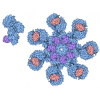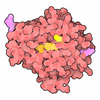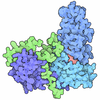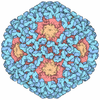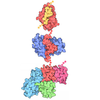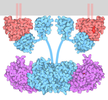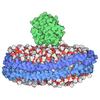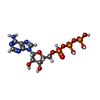+ Open data
Open data
- Basic information
Basic information
| Entry | Database: PDB / ID: 8fvu | ||||||
|---|---|---|---|---|---|---|---|
| Title | Cryo-EM structure of human Needle/NAIP/NLRC4 (R288A) | ||||||
 Components Components |
| ||||||
 Keywords Keywords | IMMUNE SYSTEM / NLRC4 / NAIP / Inflammasome | ||||||
| Function / homology |  Function and homology information Function and homology informationanthrax lethal factor endopeptidase / IPAF inflammasome complex / The IPAF inflammasome / icosanoid biosynthetic process / canonical inflammasome complex / caspase binding / type III protein secretion system complex / positive regulation of protein processing / protein secretion by the type III secretion system / cysteine-type endopeptidase inhibitor activity involved in apoptotic process ...anthrax lethal factor endopeptidase / IPAF inflammasome complex / The IPAF inflammasome / icosanoid biosynthetic process / canonical inflammasome complex / caspase binding / type III protein secretion system complex / positive regulation of protein processing / protein secretion by the type III secretion system / cysteine-type endopeptidase inhibitor activity involved in apoptotic process / pattern recognition receptor signaling pathway / host cell cytosol / TP53 Regulates Transcription of Caspase Activators and Caspases / pyroptotic inflammatory response / Uptake and function of anthrax toxins / cysteine-type endopeptidase inhibitor activity / negative regulation of tumor necrosis factor-mediated signaling pathway / endopeptidase activator activity / detection of bacterium / protein serine/threonine kinase binding / activation of innate immune response / positive regulation of interleukin-1 beta production / positive regulation of JNK cascade / protein homooligomerization / metalloendopeptidase activity / positive regulation of inflammatory response / metallopeptidase activity / positive regulation of NF-kappaB transcription factor activity / nervous system development / toxin activity / basolateral plasma membrane / regulation of apoptotic process / negative regulation of neuron apoptotic process / defense response to bacterium / positive regulation of apoptotic process / inflammatory response / innate immune response / intracellular membrane-bounded organelle / apoptotic process / negative regulation of apoptotic process / magnesium ion binding / cell surface / protein homodimerization activity / ATP hydrolysis activity / proteolysis / extracellular region / zinc ion binding / ATP binding / metal ion binding / identical protein binding / plasma membrane / cytosol / cytoplasm Similarity search - Function | ||||||
| Biological species |  Homo sapiens (human) Homo sapiens (human)  Burkholderia (bacteria) Burkholderia (bacteria) | ||||||
| Method | ELECTRON MICROSCOPY / single particle reconstruction / cryo EM / Resolution: 3.6 Å | ||||||
 Authors Authors | Matico, R.E. / Yu, X. / Miller, R. / Somani, S. / Ricketts, M.D. / Kumar, N. / Steele, R.A. / Medley, Q. / Berger, S. / Faustin, B. / Sharma, S. | ||||||
| Funding support | 1items
| ||||||
 Citation Citation |  Journal: Nat Struct Mol Biol / Year: 2024 Journal: Nat Struct Mol Biol / Year: 2024Title: Structural basis of the human NAIP/NLRC4 inflammasome assembly and pathogen sensing. Authors: Rosalie E Matico / Xiaodi Yu / Robyn Miller / Sandeep Somani / M Daniel Ricketts / Nikit Kumar / Ruth A Steele / Quintus Medley / Scott Berger / Benjamin Faustin / Sujata Sharma /  Abstract: The NLR family caspase activation and recruitment domain-containing 4 (NLRC4) inflammasome is a critical cytosolic innate immune machine formed upon the direct sensing of bacterial infection and in ...The NLR family caspase activation and recruitment domain-containing 4 (NLRC4) inflammasome is a critical cytosolic innate immune machine formed upon the direct sensing of bacterial infection and in response to cell stress during sterile chronic inflammation. Despite its major role in instigating the subsequent host immune response, a more complete understanding of the molecular events in the formation of the NLRC4 inflammasome in humans is lacking. Here we identify Bacillus thailandensis type III secretion system needle protein (Needle) as a potent trigger of the human NLR family apoptosis inhibitory protein (NAIP)/NLRC4 inflammasome complex formation and determine its structural features by cryogenic electron microscopy. We also provide a detailed understanding of how type III secretion system pathogen components are sensed by human NAIP to form a cascade of NLRC4 protomer through a critical lasso-like motif, a 'lock-key' activation model and large structural rearrangement, ultimately forming the full human NLRC4 inflammasome. These results shed light on key regulatory mechanisms specific to the NLRC4 inflammasome assembly, and the innate immune modalities of pathogen sensing in humans. | ||||||
| History |
|
- Structure visualization
Structure visualization
| Structure viewer | Molecule:  Molmil Molmil Jmol/JSmol Jmol/JSmol |
|---|
- Downloads & links
Downloads & links
- Download
Download
| PDBx/mmCIF format |  8fvu.cif.gz 8fvu.cif.gz | 492.8 KB | Display |  PDBx/mmCIF format PDBx/mmCIF format |
|---|---|---|---|---|
| PDB format |  pdb8fvu.ent.gz pdb8fvu.ent.gz | 384 KB | Display |  PDB format PDB format |
| PDBx/mmJSON format |  8fvu.json.gz 8fvu.json.gz | Tree view |  PDBx/mmJSON format PDBx/mmJSON format | |
| Others |  Other downloads Other downloads |
-Validation report
| Summary document |  8fvu_validation.pdf.gz 8fvu_validation.pdf.gz | 1.4 MB | Display |  wwPDB validaton report wwPDB validaton report |
|---|---|---|---|---|
| Full document |  8fvu_full_validation.pdf.gz 8fvu_full_validation.pdf.gz | 1.4 MB | Display | |
| Data in XML |  8fvu_validation.xml.gz 8fvu_validation.xml.gz | 69.2 KB | Display | |
| Data in CIF |  8fvu_validation.cif.gz 8fvu_validation.cif.gz | 105 KB | Display | |
| Arichive directory |  https://data.pdbj.org/pub/pdb/validation_reports/fv/8fvu https://data.pdbj.org/pub/pdb/validation_reports/fv/8fvu ftp://data.pdbj.org/pub/pdb/validation_reports/fv/8fvu ftp://data.pdbj.org/pub/pdb/validation_reports/fv/8fvu | HTTPS FTP |
-Related structure data
| Related structure data |  29493MC  8fw2C  8fw9C M: map data used to model this data C: citing same article ( |
|---|---|
| Similar structure data | Similarity search - Function & homology  F&H Search F&H Search |
- Links
Links
- Assembly
Assembly
| Deposited unit | 
|
|---|---|
| 1 |
|
- Components
Components
| #1: Protein | Mass: 160484.359 Da / Num. of mol.: 1 Source method: isolated from a genetically manipulated source Source: (gene. exp.)  Homo sapiens (human) / Gene: NAIP, BIRC1 / Production host: Homo sapiens (human) / Gene: NAIP, BIRC1 / Production host:  | ||
|---|---|---|---|
| #2: Protein | Mass: 116941.531 Da / Num. of mol.: 1 / Mutation: R288A Source method: isolated from a genetically manipulated source Source: (gene. exp.)  Homo sapiens (human) / Gene: NLRC4, CARD12, CLAN, CLAN1, IPAF, UNQ6189/PRO20215 / Production host: Homo sapiens (human) / Gene: NLRC4, CARD12, CLAN, CLAN1, IPAF, UNQ6189/PRO20215 / Production host:  | ||
| #3: Protein | Mass: 42830.836 Da / Num. of mol.: 1 Source method: isolated from a genetically manipulated source Source: (gene. exp.)   Burkholderia (bacteria) Burkholderia (bacteria)Gene: lef, pXO1-107, BXA0172, GBAA_pXO1_0172, BPSS1548 / Production host:  References: UniProt: P15917, UniProt: Q63K18, anthrax lethal factor endopeptidase | ||
| #4: Chemical | ChemComp-ATP / | ||
| #5: Chemical | | Has ligand of interest | Y | |
-Experimental details
-Experiment
| Experiment | Method: ELECTRON MICROSCOPY |
|---|---|
| EM experiment | Aggregation state: PARTICLE / 3D reconstruction method: single particle reconstruction |
- Sample preparation
Sample preparation
| Component |
| ||||||||||||||||||||||||
|---|---|---|---|---|---|---|---|---|---|---|---|---|---|---|---|---|---|---|---|---|---|---|---|---|---|
| Source (natural) |
| ||||||||||||||||||||||||
| Source (recombinant) |
| ||||||||||||||||||||||||
| Buffer solution | pH: 7.5 | ||||||||||||||||||||||||
| Specimen | Embedding applied: NO / Shadowing applied: NO / Staining applied: NO / Vitrification applied: YES | ||||||||||||||||||||||||
| Vitrification | Cryogen name: ETHANE |
- Electron microscopy imaging
Electron microscopy imaging
| Microscopy | Model: TFS GLACIOS |
|---|---|
| Electron gun | Electron source:  FIELD EMISSION GUN / Accelerating voltage: 200 kV / Illumination mode: FLOOD BEAM FIELD EMISSION GUN / Accelerating voltage: 200 kV / Illumination mode: FLOOD BEAM |
| Electron lens | Mode: BRIGHT FIELD / Nominal defocus max: 2400 nm / Nominal defocus min: 1200 nm |
| Image recording | Electron dose: 40 e/Å2 / Film or detector model: FEI FALCON IV (4k x 4k) |
- Processing
Processing
| CTF correction | Type: PHASE FLIPPING AND AMPLITUDE CORRECTION |
|---|---|
| 3D reconstruction | Resolution: 3.6 Å / Resolution method: FSC 0.143 CUT-OFF / Num. of particles: 106381 / Symmetry type: POINT |
 Movie
Movie Controller
Controller





 PDBj
PDBj
